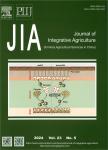Tree-Temperature Monitoring for Frost Protection of Orchards in Semi-Arid Regions Using Sprinkler Irrigation
Tree-Temperature Monitoring for Frost Protection of Orchards in Semi-Arid Regions Using Sprinkler Irrigation作者机构:Irrigation DepartmentCollege of AgricultureShiraz University
出 版 物:《Agricultural Sciences in China》 (中国农业科学(英文版))
年 卷 期:2009年第8卷第1期
页 面:98-107页
核心收录:
学科分类:09[农学] 0902[农学-园艺学] 090201[农学-果树学]
基 金:Research of the Shiraz University Technology Committee of Fars Province, I.R. Iran
主 题:automated sprinkler irrigation FROSTPORO frost protection peach orchard orange orchard
摘 要:Automated over-tree sprinkler irrigation systems were developed and tested in two orchards located in two separate locations in southern Iran (a 0.17 ha peach orchard and a 0.24 ha orange orchard) to protect peach blossoms and orange trees leaves and fruits from low temperature damage. The experiment used a system that monitored the trees and air temperatures using two thermistors. The water application rate by the irrigation system was determined by an energy balance as implemented by the software FROSTPRO, In the peach orchard, the system was tested during three frost events during the spring of 2003 and three other events during the spring of 2004. The system successfully kept peach flowers above the critical temperature, i.e., -4.0℃ in spring 2004 (control block -4.12℃, and sprinkled block +0.5℃) during all events. Similar results were obtained in the orange orchard during three frost events in the winter of 2004, during which the tree temperatures were at least 2.5℃ above the critical temperature. Results from field tests show that the system can effectively protect the peach blossoms from damage. Determination done after the frost events showed a 12% blossom kill in the sprinkled blocks while in the unsprinkled control block a 41.5% blossom kill. Calculations indicated that when using variable application rates, the amount of water used can be reduced by 54.3%. Spatial distribution of minimum temperatures during the three frosts was also studied in Jahrom, Iran. Results showed a significant temperature control in the experimental block, especially in the central part of the orchard, but the block margins (about 3.6% of the total area) were at the risk of low temperature due to the wind drift effects.



